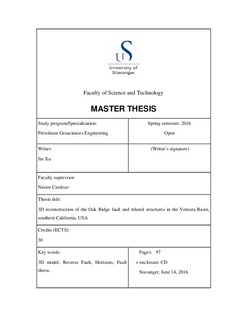| dc.contributor.author | Xu, Jin | |
| dc.coverage.spatial | California, Ventura Basin | nb_NO |
| dc.date.accessioned | 2016-10-12T14:30:18Z | |
| dc.date.available | 2016-10-12T14:30:18Z | |
| dc.date.issued | 2016-06 | |
| dc.identifier.uri | http://hdl.handle.net/11250/2414777 | |
| dc.description | Master's thesis in Petroleum engineering | nb_NO |
| dc.description.abstract | The Oak Ridge fault is located in the Ventura Basin, southern California, USA. It is a south-dipping reverse fault formed under the effect of Miocene extension, followed by Pliocene to middle Pleistocene compression, late Quaternary uplift and associated clockwise rotation of the western Transverse Ranges. In this thesis, the integration of well data, well image, subsurface maps, fault interpretation and public well correlations were used to interpret cross sections and build a 3D structural model of the Oak Ridge fault in an area of about 500 km2. The 3D model contains 36 cross sections, 2 fault planes and 6 horizons. Based on the strike variation of the Oak Ridge fault, the model was subdivided into four segments: (1) NE-SW striking coastal segment with an eastwards increased dip angle up to 80 degrees, (2) NE-SW striking segment dipping 85 degrees, (3) ENE-WSW striking segment with an eastwards decreasing dip angle from 80 degrees to 60 degrees, and (4) N-E striking segment with an eastward increasing dip angle from 60 to 80 degrees. With the well tops and dip meter data control, in the region from coastal area to the Santa Paula city, horizon modeling was performed on both hanging wall and footwall block. However, in the area from Santa Paula city to the eastern end, the top Santa Barbara and top Pico surfaces were made in the footwall block, while only the top Sespe surface was made in the hanging wall. Unfaulted horizons show a monoclinal structure in the western area. To the east, the Oak Ridge fault offset all horizons. The hanging wall Sespe horizon expresses an anticlinal structure due to late Quaternary uplift deformation, while the footwall Pico and Santa Barbara horizons show a synclinal structure. Cross sections interpretation and final model show that the thickness of the Pliocene Pico and Pleistocene Santa Barbara strata decreases eastwards on the hanging wall but increases eastwards on the footwall from the coastal area to the Santa Paula city. Fault displacement analysis shows the displacement of Oak Ridge fault decreases westwards. The 3D structural model built in this study can be used to improve the understanding of the large number of fields in the Ventura Basin, which its developments are linked to the Oak Ridge fault. | nb_NO |
| dc.language.iso | eng | nb_NO |
| dc.publisher | University of Stavanger, Norway | nb_NO |
| dc.relation.ispartofseries | Masteroppgave/UIS-TN-IPT/2016; | |
| dc.subject | petroleumsteknologi | nb_NO |
| dc.subject | petroleum engineering | nb_NO |
| dc.subject | 3D model | nb_NO |
| dc.subject | petroleum geosciences engineering | nb_NO |
| dc.subject | reverse fault | nb_NO |
| dc.subject | horizons | nb_NO |
| dc.subject | fault throw | nb_NO |
| dc.subject | petroleumsgeologi | |
| dc.title | 3D reconstruction of the Oak Ridge fault and related structures in the Ventura Basin, southern California, USA | nb_NO |
| dc.type | Master thesis | nb_NO |
| dc.subject.nsi | VDP::Technology: 500::Rock and petroleum disciplines: 510::Geological engineering: 513 | nb_NO |
